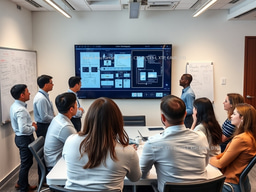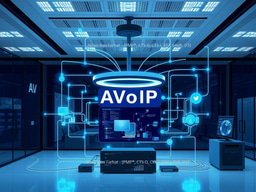The Convergence That’s Redefining the Industry ( AV and IT)

Not long ago, the audiovisual world was built around connectors, racks and acoustics. The expertise that defined a top AV engineer was grounded in understanding signal flow, impedance matching, projection throw ratios and acoustic treatment.
Today, that foundation is still valuable but the landscape has shifted dramatically. Now, we talk about network switches, VLAN configurations and IP addressing schemes as much as we discuss audio levels and projector lumens. The AV industry is no longer operating in its own isolated space. It has stepped directly into the IT domain, creating a blended discipline that demands mastery of both worlds.
So the first questions to be asked : Why the Convergence Is Happening ? Several factors are driving this AV–IT convergence:
- Transition to AV over IP:
I noticed that the shifting from traditional baseband video (HDMI, SDI, VGA) to network-based transport is arguably the most significant transformation in decades. AV content is now compressed, packetized and streamed over Ethernet using protocols like Dante, NDI, AES67 and ST 2110. This requires not just an understanding of AV signal quality, but also of multicast routing, bandwidth provisioning and latency management. - Enterprise Integration Requirements:
I know that AV systems are no longer stand-alone. They are expected to integrate with corporate IT ecosystems, tying into Active Directory, working with enterprise authentication methods and sharing infrastructure with mission-critical business applications. That means AV must adhere to IT standards for uptime, security and interoperability. - The Rise of Remote and Hybrid Work:
The global shift to hybrid and remote work has accelerated the demand for networked conferencing, streaming and collaboration platforms. Platforms like Microsoft Teams Rooms, Zoom Rooms and Cisco Webex now sit at the intersection of AV presentation and IT network management. - Cybersecurity Concerns:
We need to admit that an AV endpoint is now an IP endpoint and that means it’s a potential attack vector. Devices such as cameras, streaming encoders and DSPs need firmware updates, secure login credentials and compliance with IT security policies. AV engineers these days must now understand firewall rules, VLAN isolation and vulnerability management.
Why Traditional AV Skills still Matters ?
A traditional AV background is far from obsolete. On the contrary, it remains critical because AV’s end goal is still user experience delivering high-quality audio, clear visuals and seamless interaction.
so the Second questions might be : what are Key strengths from traditional AV and what it can include:
- Audio Physics and Acoustics:
Understanding sound propagation, microphone placement, reverberation time and speaker coverage patterns remains vital. Digital signal processing can correct some problems, but nothing replaces good acoustic design. - Video Formats and Signal Flow:
Knowledge of resolution, frame rate, color space and video scaling ensures the delivered image meets expectations. Even in a networked world, a poor understanding of signal paths can cripple performance. - Systems Integration:
Bringing together multiple devices, control systems and signal paths into a cohesive, reliable solution is an art that AV veterans excel at.
For today’s AV professional, IT skills are no longer “nice to have”, they’re essential:
- Network Architecture: Understanding Layer 2 and Layer 3 topologies, multicast routing (IGMP Snooping, PIM) and bandwidth planning.
- Switch Configuration: Setting up VLANs for AV traffic, configuring QoS to prioritize real-time media streams and ensuring redundancy through protocols like Spanning Tree or link aggregation.
- Cybersecurity Best Practices: Implementing password policies, firmware updates and network segmentation to protect AV devices.
- Scalability and Redundancy: Designing systems that can expand without redesign and that remain operational even when components fail.
The most valuable people in today’s AV landscape speak both languages, AV and IT. They know that:
- A DSP configuration might be perfect, but without QoS on the switch, audio will still drop out.
- A 4K video stream over IP might look flawless on paper, but without proper multicast management, it will flood the network.
- A camera might produce stunning images, but without proper firewall and firmware management, it’s a security risk.
This dual expertise allows them to design resilient, scalable and secure systems that not only work in a lab but perform reliably in live environments.
Today’s systems look very different from their analog ancestors:
- Stream content over IP rather than relying solely on direct video cables.
- Interact with enterprise networks, often sharing the same infrastructure as business-critical systems.
- Require high availability in some cases, five nines (99.999% uptime) to meet business and operational demands.
- Integrate with cloud platforms, enabling monitoring, analytics and remote control.
When designing, professionals must consider:
- Bandwidth Requirements : Uncompressed 4K video over IP can exceed 10 Gbps per stream; compression reduces this but introduces latency.
- Latency Targets: For live events, anything over 100 ms can be noticeable; for conferencing, low latency is crucial for natural conversation.
- Security Posture: Devices must comply with IT’s patching schedules and vulnerability assessments.
- During planning, to ensure AV bandwidth needs and VLAN designs are included in IT’s roadmap.
- During deployment, to avoid last-minute conflicts over switch ports or firewall rules.
- If you come from an AV background, start learning about networking fundamentals, cybersecurity and enterprise IT workflows.
If you come from IT, explore audio engineering, video processing and human-centered design principles in AV.
So the AV–IT convergence is not a trend, it’s a permanent evolution. Technologies like AV over IP, cloud-based control systems and AI-powered analytics will only deepen the integration between these worlds.
For professionals, the takeaway is clear: adapt or risk becoming obsolete.
The future belongs to the hybrid professional, someone who can walk into a meeting with IT directors and talk about VLAN tagging, then walk into a client demo and explain why microphone polar patterns matter.
Finally we’re living in the most exciting era the AV industry has ever seen. The move from isolated, hardware-bound systems to fully integrated, networked solutions has expanded what’s possible — from global corporate collaboration to immersive, interactive environments that were once science fiction.
Whether you’re an integrator, a consultant, or an in-house AV/IT manager, your value in 2025 and beyond will be determined by your ability to bridge two worlds: the creative, sensory-focused realm of AV and the structured, data-driven discipline of IT.
The convergence is here. The question is: are you ready to master both languages?
-
Xchange Advocates are recognized AV/IT industry thought leaders and influencers. We invite you to connect with them and follow their activity across the community as they offer valuable insights and expertise while advocating for and building awareness of the AV industry.
Recommended Content
LetsTalkAVbyAlexis Series: Episode 4 : Design Begins With People: Engineering AV Systems Around Real End-User Requirements

LetsTalkAVbyAlexis Series : Episode 2: Network & AV Convergence (AVoIP)





Please sign in or register for FREE
If you are a registered user on AVIXA Xchange, please sign in
Real-time connectivity will change the world!
100 %